If you wonder what white balance does or why it is necessary: The reason is that as soon as the scene is lighted by a light source with a spectrum different from the sun, the colours are different from what we expect. Our eye sends these wrong colours to our brain. Our brain is able to do some sort of white balance. But it is by no means perfect. Have you ever bought a shirt in a store with mainly artyificial light, went out of the shop and realized that it looks terrible? Then, your brain was not able to do a 100% white balance. It is similar with digital cameras. Actually, the automatic white balance algorithms are fairly sophisticated and some manufacturers are better than others in implementing them.
I noticed that the custom white balance of the 2040 is awesome! It really has a huuuge adjustment range. In fact, it is able to make the strong red cast disappear completely. It is even possible to turn it into a green cast when balancing on a reddish surface. This is probably not useful, but it shows the excellence of the Olympus' feature. The Minolta D7, however advanced she is, has a very weak custom white balance. The latitude of the settings is really only able to correct the relatively weak cast that comes from artificial light sources.
For more info on light sources and their effect on white balance you should visit micro.magnet.fsu.edu/optics/lightandcolor/sources.html. A very excellent source, describing the spectrum emitted by different light sources. You can see that Tungsten lamps are mostly red. This is pretty similar to what a camera sees through a mild IR filter like the Heliopan 715nm I currently use. I guess this is the reason why the Tungsten white balance gives nice pictures.
After my shootings, I had the feeling, that whitebalance influences sensitivity. Could this really be? Zayla has written a very interesting message in this thread over at dpreview. Zayla noticed that the camera tends to end exposure when one channel clips. When using a IR pass filter, this is commonly the red channel. Thus, you would obtain a picture with nearly no info in the green and blue channels. There are two ways to remedy this: a) shoot in B&W b) use custom white balance. B&W works, as it is basically the average of the R, G, B channels for any given pixel. Custom white balance works because the individual amplification of each channel is adjusted in a way that prevents one channel from clipping way before the other. I'd suggest shooting colour = custom white balance. But if your camera does not offer it, make sure you give B&W a try. However, please note that both methods will decrease apparent sensitivity: The IR-sensitive red channel is now less important and the light that was once collected by the red sensor elements must now be provided be the insensitive blue and green ones.
I will surely have to produce some evidence in form of images, but until then you might want to keep it in mind. Update: Have a look at my Nikon 5100 sensitivity page for more on the effect of WB with IR.
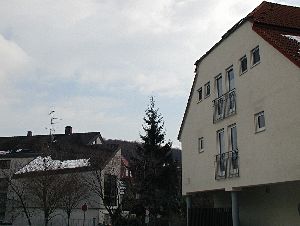
Filter: none
Exposure time: 1/400
F-stop: 7.0
ISO speed: 100
Focal length: 8.0000
White balance: Automatic
aEV: 14.2586
comments: good rendition of scene
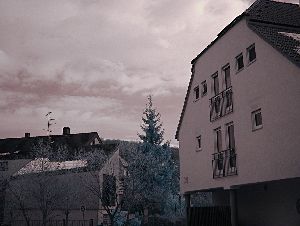
Filter: Heliopan 715nm IR pass filter
Exposure time: 1/60
F-stop: 2.0
ISO speed: 100
Focal length: 8.0000
White Balance: Automatic
aEV: 7.9069
comments: very nice colours
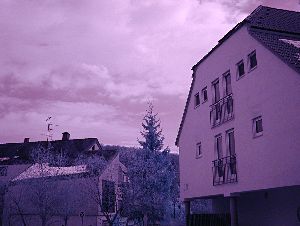
Filter: Heliopan 715nm IR pass filter
Exposure time: 1/60
F-stop: 2.0
ISO speed: 100
Focal length: 8.0000
White balance: Tungsten
aEV: 7.9069
comments: purple cast
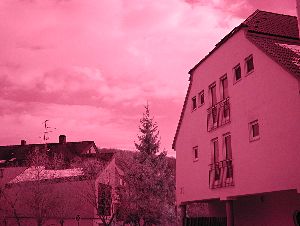
Filter: Heliopan 715nm IR pass filter
Exposure time: 1/80
F-stop: 2.0
ISO speed: 100
Focal length: 8.0000
White balance: Fluorescent
aEV: 8.3219
comments: pinkish-red cast
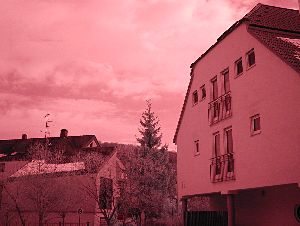
Filter: Heliopan 715nm IR pass filter
Exposure time: 1/60
F-stop: 2.0
ISO speed: 100
Focal length: 8.0000
White balance: Daylight
aEV: 7.9069
comments: red cast
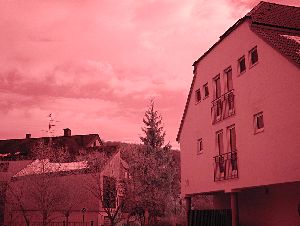
Filter: Heliopan 715nm IR pass filter
Exposure time: 1/60
F-stop: 2.0
ISO speed: 100
Focal length: 8.0000
White balance: D55
aEV: 7.9069
comments: looks very much like "daylight"
Without IR cut-filter!
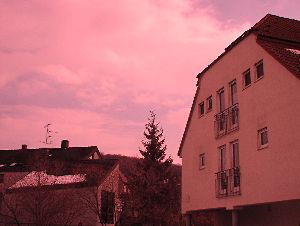
Filter: none
Exposure time: 1/500
F-stop: 10.0
ISO speed: 100
Focal length: 8.1000
White balance: Automatic
aEV: 15.6096
comments: strong red cast in visible light due to removal of cyan-coloured IR cut-filter
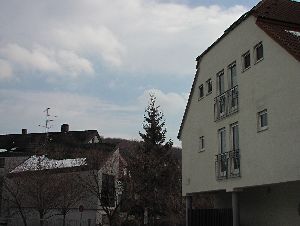
Filter: none
Exposure time: 1/650
F-stop: 8.0
ISO speed: 100
Focal length: 8.1000
White balance: Custom
aEV: 15.3443
comments: Wow! Looks pretty nice. Visible light photography is obviously possible with the 2040IR.
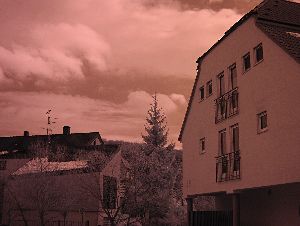
Filter: Heliopan 715nm IR pass filter
Exposure time: 1/650
F-stop: 4.5
ISO speed: 100
Focal length: 8.1000
White balance: Custom, taken from the last shot (balanced without IR pass filter)
aEV: 13.6841
comments: Interesting! Mild red cast with the custom white balance I did without the IR pass filter.
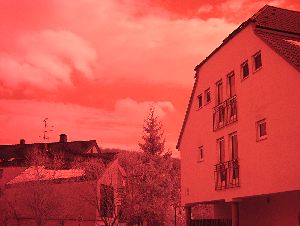
Filter: Heliopan 715nm IR pass filter
Exposure time: 1/500
F-stop: 4.5
ISO speed: 100
Focal length: 8.1000
White balance: Automatic
aEV: 13.3056
comments: Strong reddish cast, just like when using automatic WB without a filter.
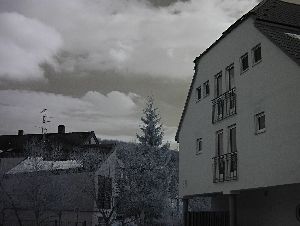
Filter: Heliopan 715nm IR pass filter
Exposure time: 1/650
F-stop: 4.0
ISO speed: 100
Focal length: 8.1000
White balance: Custom
aEV: 13.3443
comments: Very nice almost greyscale colours with custom white balance set with the IR pass filter on
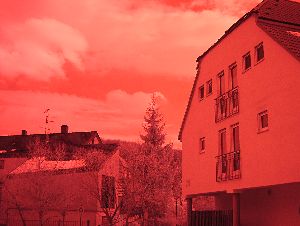
Filter: Heliopan 715nm IR pass filter
Exposure time: 1/650
F-stop: 4.0
ISO speed: 100
Focal length: 8.1000
White balance: D55
aEV: 13.3443
comments: strong red cast
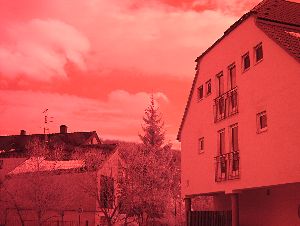
Filter: Heliopan 715nm IR pass filter
Exposure time: 1/650
F-stop: 4.0
ISO speed: 100
Focal length: 8.1000
White balance: Daylight
aEV: 13.3443
comments: seems a bit less saturated than D55
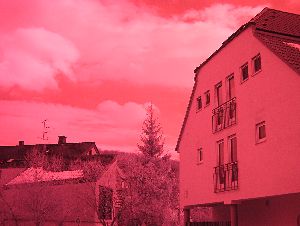
Filter: Heliopan 715nm IR pass filter
Exposure time: 1/500
F-stop: 4.5
ISO speed: 100
Focal length: 8.1000
White balance: Fluorescent
aEV: 13.3056
comments: red with a little bit of purple
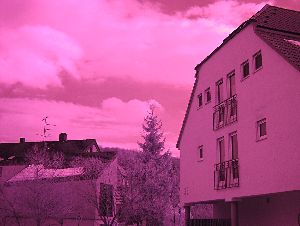
Filter: Heliopan 715nm IR pass filter
Exposure time: 1/500
F-stop: 4.5
ISO speed: 100
Focal length: 8.1000
White balance: Tungsten
aEV: 13.3056
comments: strong magenta cast
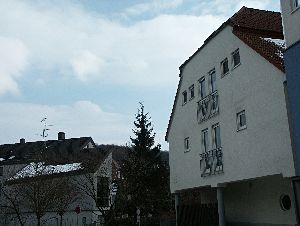
Filter: none
Exposure time: 1/500
F-stop: 8.0
ISO speed: 100
Focal length: 10.2109
White balance: Automatic
aEV: 14.9658
comments: pretty nice colours
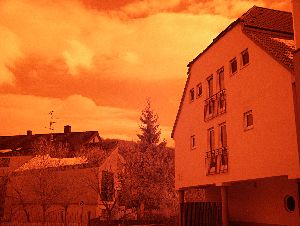
Filter: Heliopan 715nm IR pass filter
Exposure time: 1/45
F-stop: 2.8
ISO speed: 200
Focal length: 10.2109
White balance: Automatic
aEV: 7.4627
comments: strong orange cast
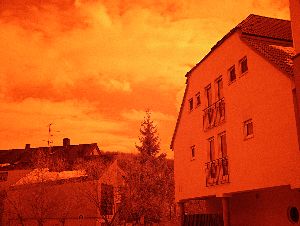
Filter: Heliopan 715nm IR pass filter
Exposure time: 1/45
F-stop: 2.8
ISO speed: 160
Focal length: 10.2109
White balance: Daylight
aEV: 7.7846
comments: seems exactly like automatic WB
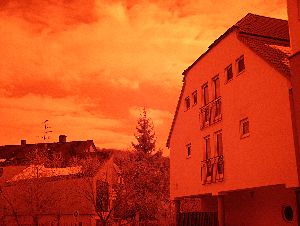
Filter: Heliopan 715nm IR pass filter
Exposure time: 1/45
F-stop: 2.8
ISO speed: 160
Focal length: 10.2109
White balance: Fluorescent
aEV: 7.7846
comments: Strangely I cannot see any difference to "Daylight"
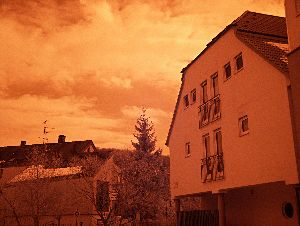
Filter: Heliopan 715nm IR pass filter
Exposure time: 1/45
F-stop: 2.8
ISO speed: 200
Focal length: 10.2109
White balance: Tungsten
aEV: 7.4627
comments: pretty beautiful orange-brownish cast
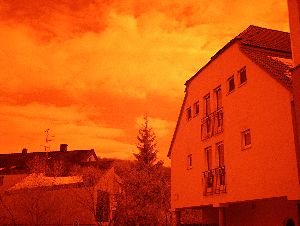
Filter: Heliopan 715nm IR pass filter
Exposure time: 1/45
F-stop: 2.8
ISO speed: 160
Focal length: 10.2109
White balance: WB10
aEV: 7.7846
comments: Once again, almost no difference to the daylight and fluorescent settings
I did not do the full list of WBs this time. I just picked out some.
As expected, automatic white balance gives a strong red cast
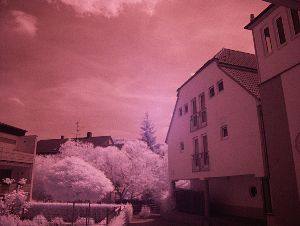
With Tungsten, it looks a little bit like an Olympus 2020, don't you think?
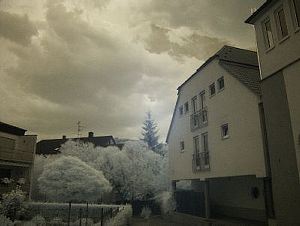
This was shot with manual white balance through the IR pass-filter. Interestingly, the White Balance of the D7IR can cope at least partly with the red colour cast. On the D7 it just refuses to work at all.
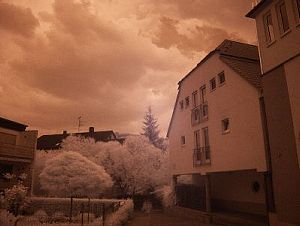
This was shot with manual white balance without the filter. After balancing on a white surface, the filter was mounted.
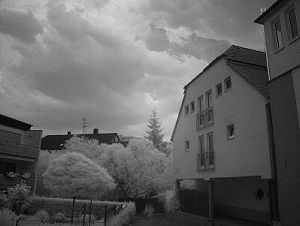
Ok, not exactly white balance, this shot was taken in B&W mode. Can you see the hotspot? It becomes very hard to see in black'n'white. Sorry, I do not remember who told me that hint!
The 2020 is easily usable for IR photography with fully automatic settings. My 2040IR is a bit more difficult to use. However, the custom white balance is easily done and gives good results in visible light with extremely short shutter speeds and awesome results in IR photography and therefore wins my personal recommendation despite its focus problems. The Minolta D7 however is quite disappointing in IR light when used without post-processing. Of course, it is the best camera of the three for visible light but has the slowest lens. It is interesting that the white balance function of the modified D7IR gives so different results. Although it is still inferior to that of the 2040IR, it's actually useful.